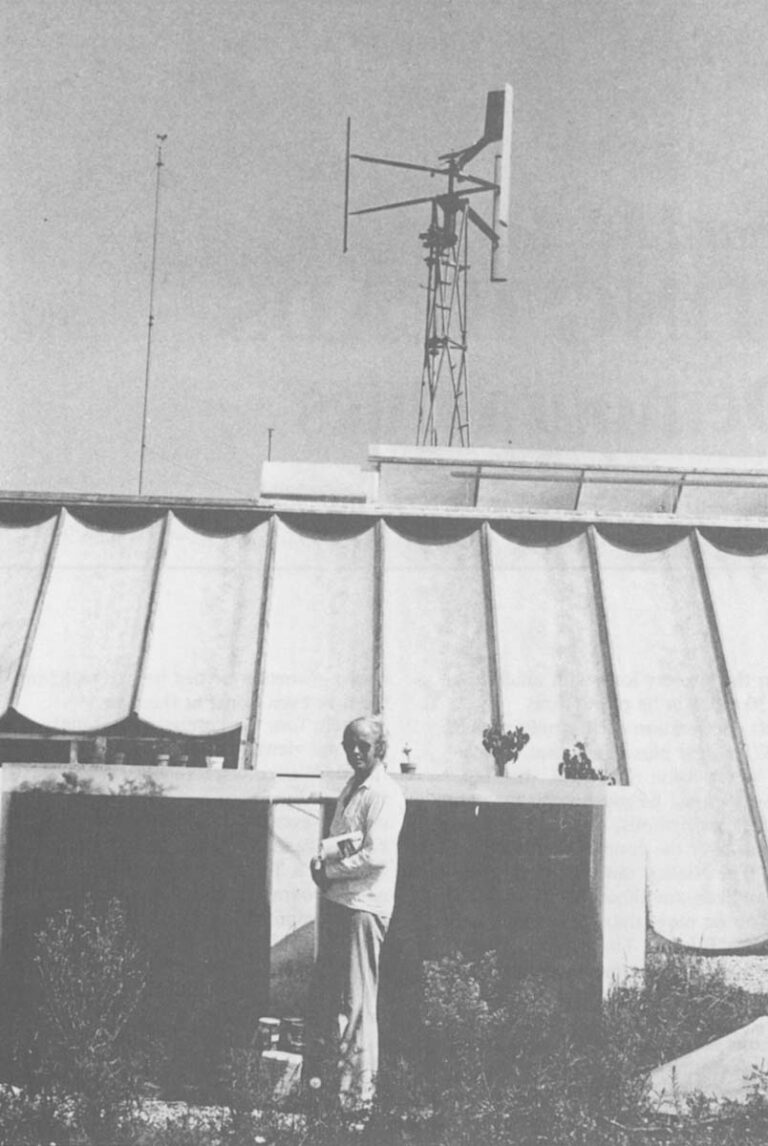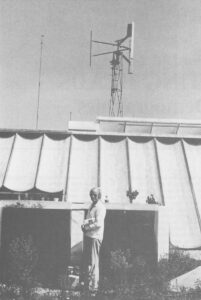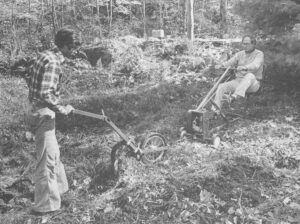“I believe that for engineers, now is going to be a totally interesting time. Things are going to have to be redesigned almost fundamentally.” John Todd, the 39-year-old founder and co-director of the New Alchemy Institute is talking, over lunch, in a yard of the institute’s Cape Cod headquarters. The aquatic biologist, a former member of Canada’s Olympic ski team, uses a carving knife to punctuate and illustrate his points, waving it, scratching diagrams on the lunch table’s rough surface. We had been using the same knife to slice onions for sandwiches; it serves as both production tool and communication device.
That, in effect, is how the new Alchemy Institute looks at the cluster of windmills and fish and vegetable production systems at the group’s 12-acre site. One of the leading groups in the emergent “appropriate technology” movement, the institute has been active for nine years designing, constructing and testing alternatives to what its members deem to be inappropriate technologies; they hope these alternatives will help inspire a change in the course of technology in general. I visited the institute two and a half years ago when I wrote a magazine article about it. The group was little known then, and the counter-technology movement it was spearheading was just as obscure. Both have grown in prominence since then, and I returned to the institute this summer to assess how both are progressing, and perhaps changing.
The institute has gotten larger. It now has 20 paid staff members and eight volunteers, about a third more full time workers than before. It has also become more respectable. Once vaguely regarded, by those who regarded it at all, as a group of middle-class hippies, it is now funded in part by the National Science Foundation, and one of its projects in Canada, for which the Ottowa government spent $325,000, was officially blessed and praised by no less respectable a figure than Prime Minister Trudeau. “Increasingly, I’m getting to meet with businessmen,” Todd also notes, “including venture capitalists.” Two years ago hardly any would have been interested in discussing what we were doing.
The most visible evidences of change at the institute are the futuristic “ark” that architecturally dominates its grounds and the electronic equipment that is increasingly being used to test, monitor and help run the New Alchemists’ food-producing systems. The ark, only half built when I was at the center before, is both symbol and substance of the Alchies’ technological philosophy. The electronics, including microcomputers, attests that this philosophy is far from a Luddite-like rejection of technological innovation.
Before lunch, Todd guided me through the ark, a term they apply to both the Cape Cod structure and to another one on Prince Edward Island, the project the Canadian government underwrote. The term reflects the group’s apprehensions about the potentially ante-deluvian state of the global environment and the mission they feel to design vessels of a landbound sort to save at least some of the threatened inhabitants. The ark’s most striking features are its south-facing array of concave fiberglass panels. They are designed to let the winter sun, which moves across the southern sky, shine into and heat the interior. The fecund world inside includes large cylindrical tanks made of the same material as the building’s solar face. Todd calls them “solar ponds”; they hold around 700 gallons each and are, he explains, prolific producers of fish, mostly a hardy, herbivorous tropical species called tilapia. Each “pond” produces up to ten times more fish per cubic yard than conventional aquaculture methods, and they require virtually none of the complex mechanical equipment that is used in most commercial fish growing. The ponds are largely self-nourishing, too, through an aqua cultural alchemy of sorts: algae thrive in the translucent containers, the plant-eating fish eat the algae and the fish’s excretions in turn feed the algae. Water from the ponds is also used in the institute’s intensive vegetable gardens and has increased the productivity of some plants, such as lettuce, up to 100 percent. The solar ponds, moreover, store heat absorbed during sunny days and radiate it throughout the ark at other times. The ponds, in fact, which cost around $200 each, “pay for themselves in head storage capability alone.” says Todd.

Walking across a small bridge reminiscent of classical oriental gardens, we move into a wonderfully fecund, thoroughly unconventional indoor garden where papaya trees, eggplants, tomatoes, herbs are all flourishing. So far 100 different plants, mostly edible ones, have been grown and monitored in the ark, which shelters and nourishes an abundant year-round source of fresh vegetables. Colleen Armstrong, one of the New Alchemists in charge of the interior mini-farm, joins us and explains how they have shunned the pesticides that usually are used to combat the insects that normally attack greenhouse plants. The appropriate technology here is deemed to be biological controls, mainly the use of beneficial insects to fight bad ones. White flies were their first major problems, she says. They introduced a tiny parasitic wasp, Encarsia Formosa that kills baby white flies before they can do any harm. “We still have them, but they’re mostly kept at harmless levels. We’ve had no trouble with them this year.”
On a platform near the middle of the ark, Todd points out a microcomputer. A suitcase-sized device, it can, he says, receive readings from 76 sensors, monitoring such variables as light, temperature, humidity, oxygen and acidity levels. Later the group’s new young systems analyst, John Wolfe, explains that the ark’s microcomputer is linked to another in a nearby converted farmhouse. Together, the computers take and record readings every fifteen minutes of the conditions in the solar ponds, Wolfe says, and these readings along with chemical samplings and production measurements are being electronically analyzed to construct a computer model that will, they hope’ replicate the multiple interactions between the many factors that effect fish growth. The knowledge thereby gained may eventually lead to some home fish production in, say, a solar pond in a sunny Bronxville living room. The model-making project is being funded by the National Science Foundation. From a recent report to the NSF, Wolfe showed me a complex diagram of the many interactions the computers are being asked to analyze.
The use of computers to analyze and aid in the control of food growing is not in itself a new technological frontier that the Alchies are pioneering. Large-scale commercial agricultural enterprises have been using computers for several years now. But what the New Alchemists are doing is bringing computer technology to bear on small-scale food growing, particularly fish farming, with the aim of making individuals and groups more self-sufficient, less dependent on the immense technological networks that now dominate the food production and distribution industry. Such goals are at the heart of the counter-technology the Alchies and other appropriate technologists are espousing-aimed at greater local control of major technological systems and their products.
We talked about their philosophies, technologies and current directions over the lunch, in sight of the solar-heated ark and three windmills- another conventional part of the unconventional technologists’ paraphernalia. Conn Nugent, co-director with Todd, shared in the lunch and discussion. Trained in law, Nugent recently ran a small foundation in Boston; he joined the New Alchemists in March.
“I have a feeling,” said Todd at one point, “that at the same time we’re seeing this pseudo-globalism in the form of multi-nationals, we’re also seeing its underside, which is the miniaturization of process. For example, I wouldn’t be surprised that with what we know technologically we could set up baby steel mills, using electronics and various other techniques. As we’re miniaturizing agriculture I think manufacturing can be miniaturized. “
“I tend to think as John does,” Nugent agreed, “that the development of the semi-conductor microprocessor industry in the past 20 years is a really good harbinger of miniaturizing technology, allowing us to make technology choices.”
What’s the matter with the choices we seem to be making now, I asked.
“To duck back to fundamentals,” Todd said, “I’m of the school that tends, to see that in the long run the present technological structure of this society is maladaptive. It was built on the assumption that petroleum-based fuels would be limitless and relatively inexpensive, so that everywhere you look, architecture, transport, agriculture, manufacturing, all of these things use an enormous amount of fuel. At the same time, we have a society that is frantically trying to correct what is a fundamentally structural problem with cosmetic solutions. For example, rather than looking at the whole transport question straight in the eye, they tend to try to devise more efficient automobiles, which buys time, but doesn’t affect fate.”
“If you look at buildings, sure they’ve put on solar collectors or insulated them more, but basically, the name of the game is not to change the underlying assumptions about buildings- namely that we’ll go to school in one, do commerce in another, manufacture in another and grow foods in another. Instead of seeing them as ecologies, we see them as single function entities.”
We are hooked, in effect, on a certain way of regarding and using technology, Todd said, and the New Alchemists hope that by developing dramatic design alternatives like the arks they can, as Todd put it, “jar” people from their addiction. “We need to capture myths,” is another way he put it.
Which brought us to our major topic of conversation- the aim of Todd and many of the New Alchemists to “capture myths” by extending the technologies and philosophies of the ark to full villages. “Our feeling is that first we had to integrate architecture with soft technologies and ecology. The little backyard fish farm [an early New Alchemy design] and the solar ponds and the arks were all a matter of assembling the components. The name of the game was to see whether they would work and how well. I think we were surprised on all counts on how things which previously were unconnected tended to be self-enhancing and work very well when brought together in these new ways.
“Then it became clear within the last year and a half that the main challenge was now implementation, getting these ideas outward into the commonplace before it became just plain difficult to do so. The whole game began to change to the idea of merging ecological ideas with economic ones. Margaret Meade feels very strongly that for these ideas to really catch hold and help inspire a generation of people that the ark concept should begin to envelop the idea of a village. I agree, and half a dozen of us here, together with a couple of architects including Sim Van der Ryn [California state architect and overseer of the state’s Office of Appropriate Technology] and nuclear- physicist- turned- solar-designer Ted Taylor at Princeton have begun to work on various design ideas. The main idea is that the village would have a degree of completeness that isn’t typical of the modern village. They would, for example, have their own energy-trapping and utilization sources. They would do their own waste treating; waste treatment would be internalized rather than spewing out in the Connecticut River or whatever river you happen to be next to. We would connect the waste cycle to the aquatic food cycle and eventually to an agricultural food cycle.” Todd scratched circles in the tabletop, then from a notebook produced a crude sketch of interconnected structures for an imagined village in a cold northern climate. “This happens to be designed for Indians, so there are fishes and geese. You don’t have much vegetable production because they don’t like to eat vegetables. The idea is to pull things together. It’s exactly the way John Wolfe described the building of a model where each of the pieces creates a larger vision. But until the pieces get together, the vision doesn’t hold.”
Nugent said he thought villages could be shaped by the environmental ethic as a motivating system of shared values akin to the theological values that inspired medieval and early American towns.
Expanding their vision to village-size is not, Todd explained, unanimously endorsed by all the New Alchemists. “There is an ideological split in this group. There are those who say that our mandate is to deal with the needs of individuals and small groups, and there are others who say no, we are social animals and therefore have to work with social forms, that we should extend our ideas out to their logical dimension, which might be the village.”
The split has its counterpart through the appropriate technology movement, reflecting a growing uneasiness with notions of technological self-sufficiency, the feeling that in seeking alternatives to the vast impersonal networks of conventional technology, the thrust of much of the movement has been too narrowly focused on the individual family or small group. It’s particularly significant, however, that the New Alchemists, whose arks epitomize a kind of familial insularity, are adjusting their sights toward larger scales.
How soon, I asked Todd, did they see the actual construction of an ecological village? Todd said there was a possibility of working with the Environmental Protection Agency to design one in the near future. He said he also hoped to organize and get backing for a series of intense three-week-long design sessions over the next two years that would bring together various experts to try to synthesize the ecological, economic, technological and social components of such a community.
It was an ambitious, utopian vision Todd was talking about, and there is no telling at this stage whether it will materialize. One recurrent theme of discussion at the institute was that though the New Alchemists and the cause they represent have gained ground since I last visited them, -they still feel they’re fighting a steep uphill battle against conventional technological ways and accompanying attitudes. Before I left, Todd gave me a copy of an article that was about to appear in an aquaculture magazine. In it, he writes: “It has not yet fully dawned on us as a society that we are already in the early phases of a post-petroleum era. We still think and behave as we did in the 1950’s [with] oversized cars, foods transported from halfway around the world, centralized energy and large multinational corporations.” Yet he feels that changes are in the making. “New forms still tentative are coming into being. Small-scale, decentralized, technologically flexible yet sophisticated energy, food, architecture and manufacturing networks are starting to emerge.”
©1978 Wade Greene
WADE GREENE’s Fellowship study is on the Appropriate Technology Movement.






